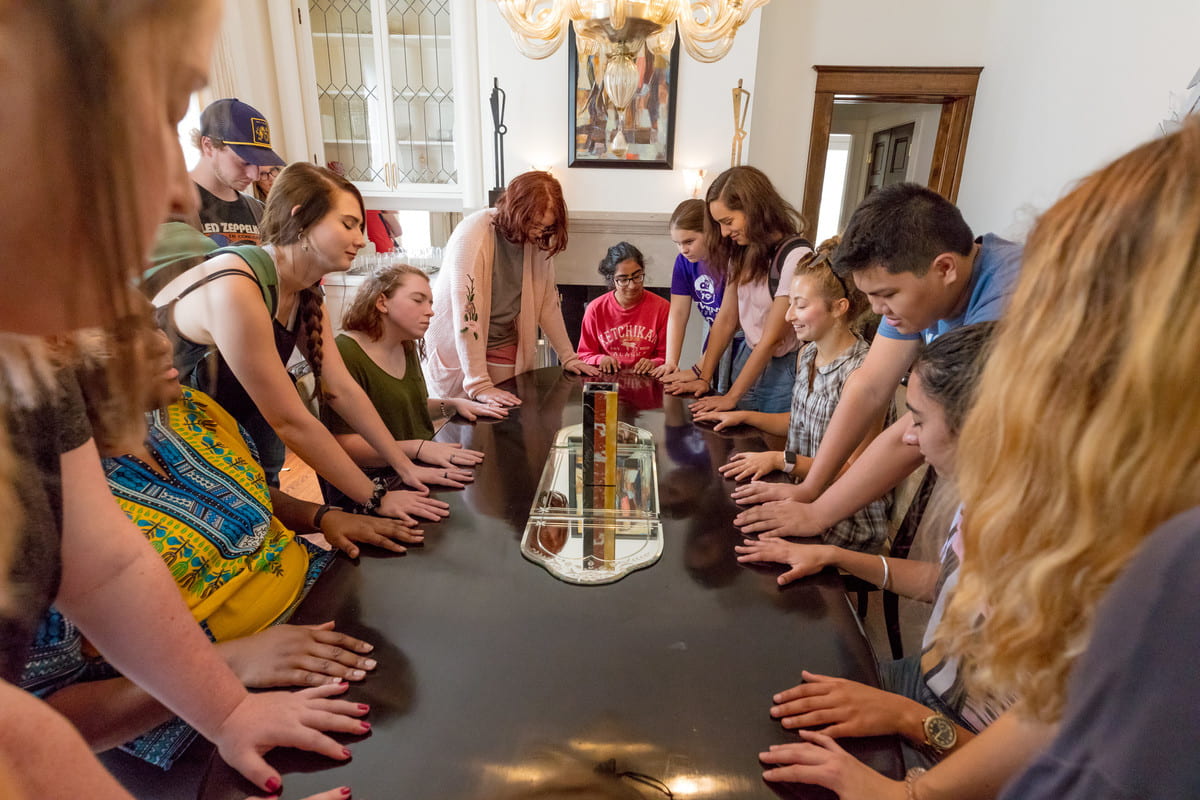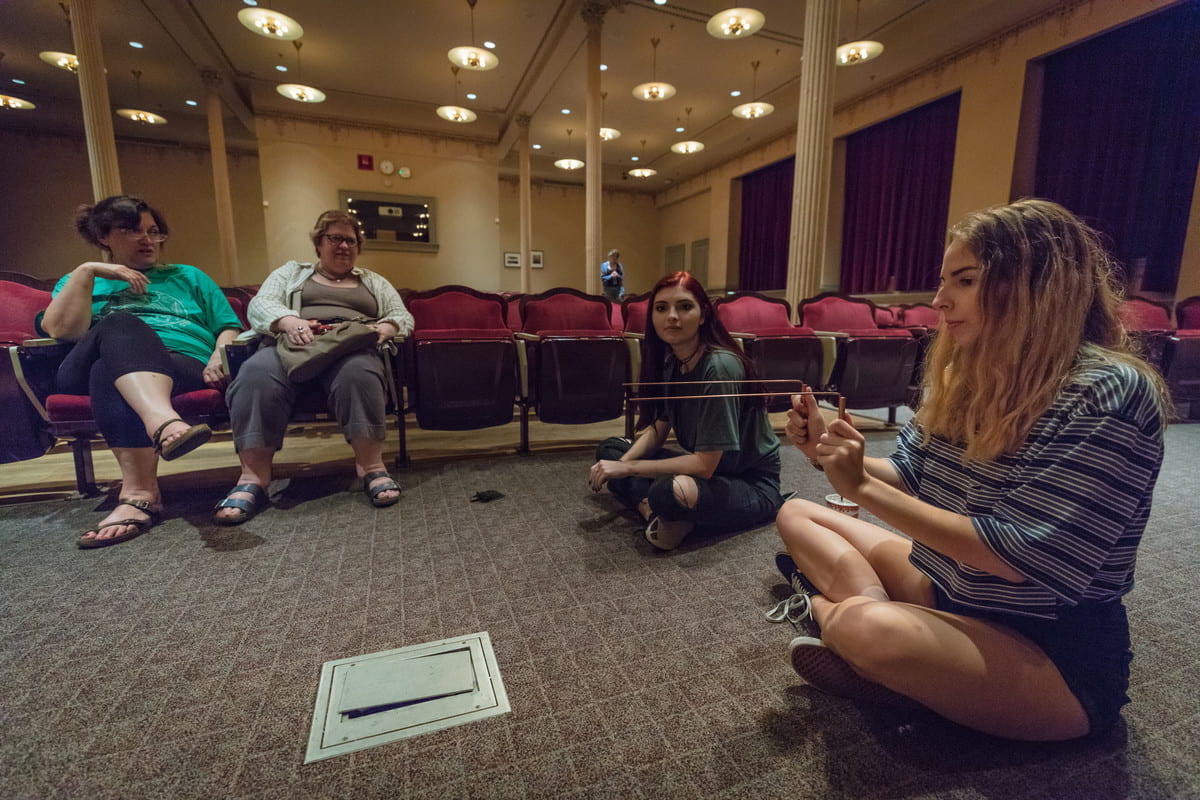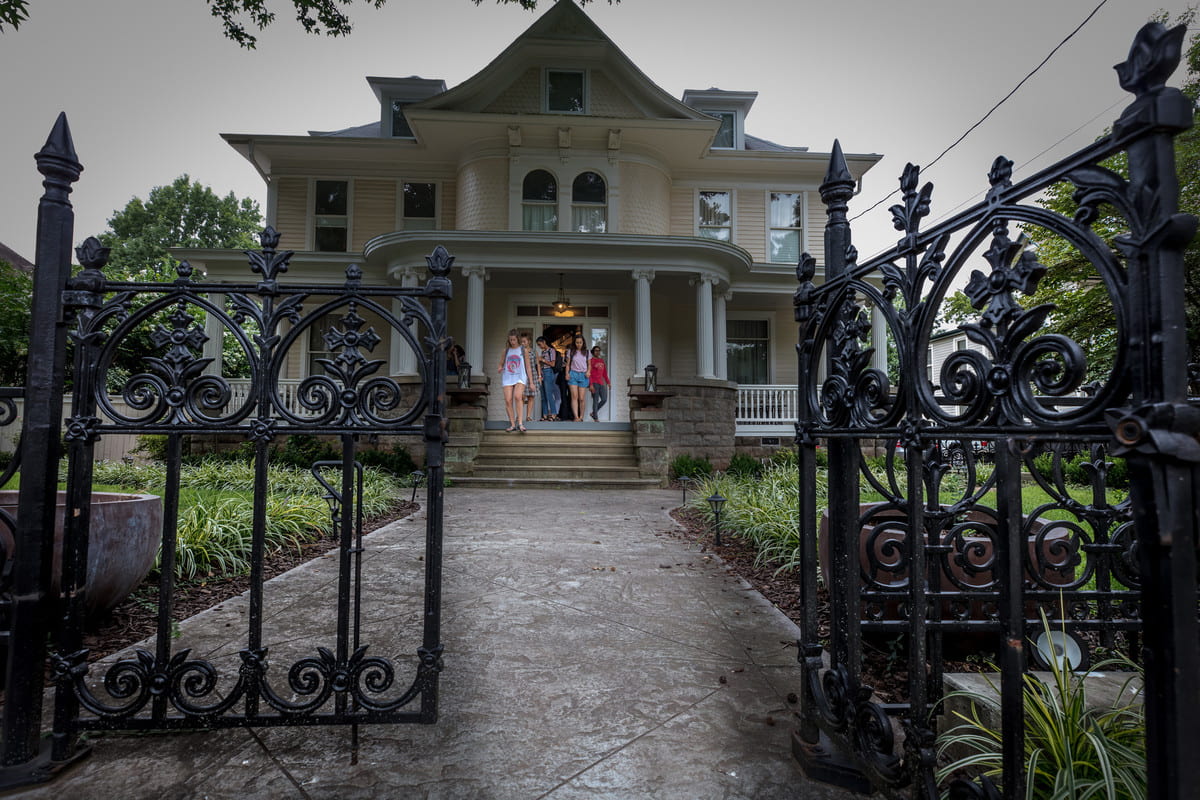Dr. Misty Bastian’s honors intersession course Ghost Hunting was an unforgettable, interdisciplinary foray into the anthropology of the otherworld. Fifteen honors students were exposed to the instruments of paranormal communication – pendulums, dowsing rods, mediums and their methods – and discussed the circumstances surrounding the current boom in paranormal interest in the United States and the culture surrounding the psychology of the paranormal experience. Not all the students believe in ghosts, but their reasons for taking the class echo each other: sheer curiosity, and a desire to have their beliefs challenged and their perspectives widened.
The class took three field trips over the two-week session, to witness the performances built up around hauntings, and to take on the roles themselves. We discuss those three field trips here.
Act I: Setting the Stage
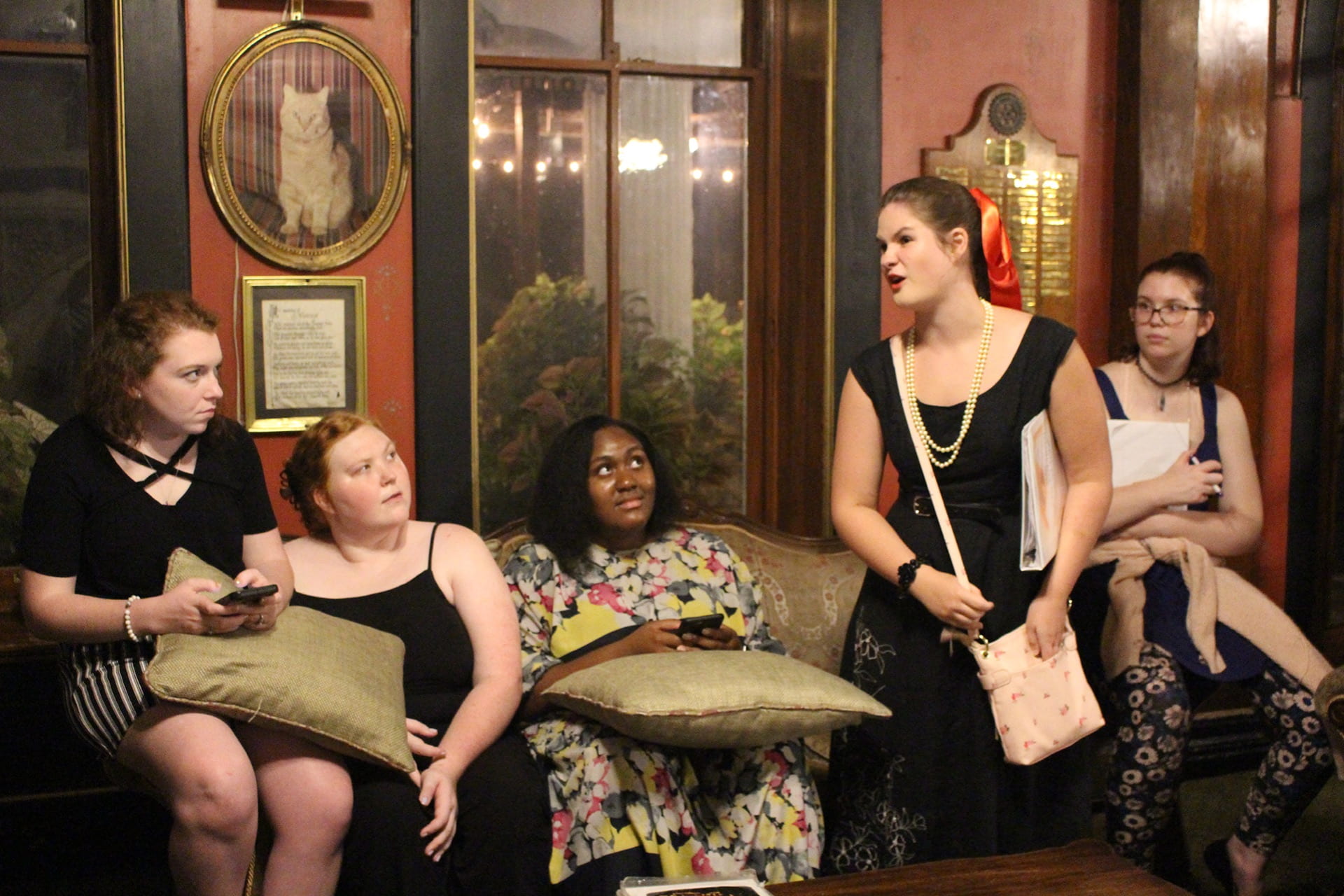
Tour guide Lily of the Valley (Lily for short) keeps the students in suspense with the story of none other than Morris, the ghost cat of The Crescent Hotel.
The name of the game at Eureka Springs’ historic Crescent Hotel is tourism. From the morgue in the basement to the busy spiritual traffic along the third-floor corridor, the ghosts are an attraction in themselves, one that never fades out of style, and one that practically advertises itself. Visitors come to the Crescent expecting to be immersed in a ghostly landscape, and the moment they step in the door, they are in a middle-space between eras: the hotel has maintained many of its original fixtures, including a doorman, and the rooms are furnished in a mix of modern and antique furniture. The ghost tour guides dress in period costumes to deepen the antique mood, and everyone, it seems, is well-versed in the town’s history, including the many hats donned by the Crescent throughout its lifetime: it has gone from hotel to girls’ school to quack cancer hospital to disrepair and, finally, back to (haunted) hotel.

Duru Erkan wonders at relics from the darkest period in The Crescent’s history: Norman Baker’s fake and fatal cancer treatment hospital.
The ghost stories are wrapped up in this history and help keep Eureka’s past alive. “I was struck by how eager the locals were to share the history of Eureka Springs,” English major Laura Hurst said. “It made the experience seem more real to me. It seemed genuine.”
Chemistry major Mandeep Kaur had a slightly different take. “It felt like a cultural memorialization of a specific time period, to appeal to a modern audience,” she said. “It was like a theme park through history.”
Bastian, a believer herself, encourages these observations. “This is part of what this class is about,” she tells the students. “Developing these analytical skills, and the ability to observe and distinguish” between what’s real and what’s crafty. This ability would come in handy for the trips to follow.
Act II: The Seance
The Stringfellow Read House in Fayetteville’s historic district was constructed in the early 1900s by the Stringfellows, who were searching for a more forgiving climate after losing their college-aged son Leslie to malaria in South Texas in the 1880s. The family would communicate with Leslie via an early variant of a Ouija board, and this history of seances and spiritualism is what draws the ghost hunters to the house today. “The theory,” said Bill Schreckhize, a political science professor and the current owner of the house, “was that the father created the seances to comfort the mother after Leslie’s death, and when Leslie finally ‘asked’ his parents to move on, it meant that the mother had found some closure at last.” The Schreckhizes are the fifth owners of the house, and they “have never experienced any ghost-like symptoms,” though the same cannot be said of previous owners of the house.
Biology major Duru Erkan is tasked with the role of medium, trying to summon up any spirits who may reside in the house – the students cluster around the dining room table, laying their hands flat on its surface with pinky fingers touching, to create a seamless ring of concentrated energy. After this role-play, Dr. Bastian brings out pendulums and dowsing rods, and the students take turns using these tools to ask yes-or-no questions, in order to glean a bit of information about the spirit they conjure.
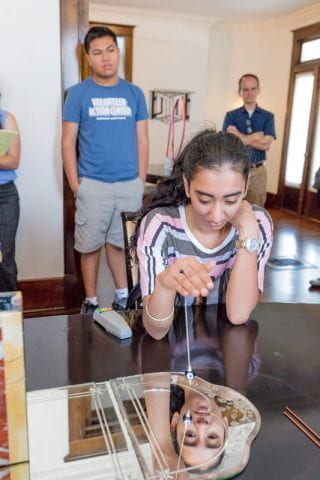
Mandeep Kaur communicates with the spirit of Leslie Stringfellow using a pendulum. The fortuitous placement of the mirror enhances the connection.
Is there a spirit here? Yes.
Are you nice to humans? Yes.
Are you male? Yes.
Did you die in this house? No.
Is there only one spirit here? Yes.
Do you want us to leave? No.
Are you Leslie? Big yes.
Do you want to hang out with us? No.
Are you happy? Yes.
Do you visit often? No.
Are you here because we are here? Yes.
Will you stay when we leave? No.
All the answers are consistent with what Schreckhize has told the students about Leslie and the history of the house. The performance is riveting, and energizing; it’s easy to suspend your disbelief. This, Bastian says, is the “emotionality” of ghost hunting. “When you get a group of people together, it’s easy to generate certain feelings.” We feed off each other, and when the history of a place is already unfamiliar to us, she says, “we start reading our own intention into it. The ambiance is created by the expectation.”
Act III: Ghost Hunting in Old Main
Wailing babies; people being strangled by invisible fingers or pushed down the stairs; mysterious figures hovering in the copy room; a bathroom so full of inexplicable happenings that women go out of their way to avoid it. It sounds like the set-up to a horror film, but all these stories come from one of the most beloved University of Arkansas symbols: Old Main. The building is the oldest on campus, and in its nearly 150-year history, has had plenty of time to attract spirits.
Tracy Henson, Sabrina Marsell and Tracy’s niece Brittany, from TSS Paranormal Investigators, accompanied our student ghost hunters in a late-night exploration of the building, focusing on areas where strange happenings have been reported. And there were strange incidences: students feeling a tense cold coming upon them, the “spirit” only dissipating when asked to move away; the sound of cracking knuckles in the dark, in response to the question: “If anyone is in here, could you give us a sign?” The first-hand testimonies of the cleaning crew, whose work hours that night coincided with the students’ own. But are these things truly evidence of ghostly presence, or can they be chalked up to coincidence and the human imagination?
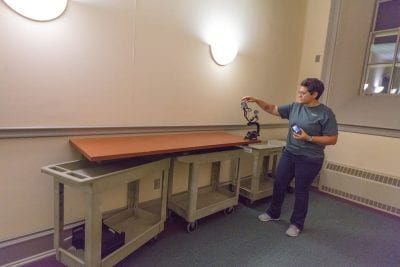
Skeptic-turned-paranormal investigator Tracy Henson sets up a recording device in a seemingly silent Old Main hallway.
Physics major Jaredan Durbin is a skeptic when it comes to ghosts, but he believes there is a certain subjective truth in paranormal investigation. “Everybody in this world is always trying to prove their truth to everyone. Paranormal investigators are no different. In the face of skepticism arises a new opportunity to improve their practice.”
“We all came into the Ghost Hunting seminar with predetermined ideas on the theory and existence of the paranormal,” says Duru Erkan. “For the purpose of the class, I forced myself to be more open…And this way, I got to have insight on a unique community that I didn’t even know existed before the class. The paranormal research in Old Main was consequently the most memorable one out of all our excursions.”
Ghost stories are eerie, especially when they’re in your backyard. Hauntings are part of the mystique of a place, part of its history and its character. They offer a stage for stories and personages who otherwise might be lost in the sands of time. As folklore, they spark community and become a stamp of the peculiar, deepening a sense of place that otherwise might be lost in the infinitely overlapping performances of the present.
Are there really ghosts in Old Main? We may never know, but the stories capture our imagination anyway, because, Jaredan Durbin says, they’re “just plain intriguing.” Despite his skepticism, Durbin enjoyed the course: “Even if I don’t believe it, it does not mean that it can’t be fun….People tell ghost stories because they are fun; they ghost hunt because it is fun. It doesn’t matter whether you believe or not.”
Want first-hand student accounts of these trips? Check out these blog posts by a skeptic, and a believer.
Read more about Leslie Stringfellow and the Stringfellow seances in Stephen Chism’s book The Afterlife of Leslie Stringfellow: A Nineteenth-Century Southern Family’s Experience with Spiritualism (University of Arkansas Press, 2005).
By Samantha Kirby

